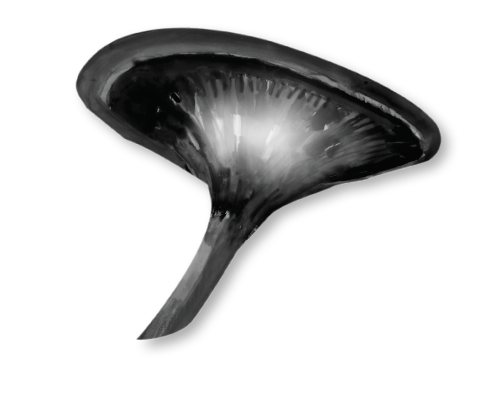
I recently found myself sitting in the crawl space of my house holding a bioluminescent mushroom. I’d been on a quest to find one of these light-producing mushrooms and, on my birthday, had collected a jack o’lantern (Omphalotus illudens), so named for its bright orange color and nighttime glow. As my eyes adjusted to the dark, no present was more exciting than watching that green glow appear along the mushroom’s gills.
Bioluminescence is light generated from chemical reactions in the bodies of living things, and beings from fireflies and jellyfish to some bacteria and –—yes — fungi can produce this effect. Bioluminescent reactions in fungi follow a basic formula: an enzyme interacts with a light-emitting compound with help from additional enzymes, water, and oxygen. The light-emitting molecules are called luciferins, and the enzymes that interact with them are called luciferases. All 120 known bioluminescent mushrooms use the same family of fungal luciferins and luciferases.
Mycologists have speculated for centuries about the reasons fungi produce light, but they don’t yet have all the answers. For one thing, which part of a fungi luminesces is different across species, implying different uses for their light.
Mycelium, the network of thread-like hyphae that are often called the “body” of a fungus, can glow, sometimes dramatically. I once saw a nighttime photograph of an entire truckload of neon-green firewood, possibly lit by the prolific mycelium of Armillaria, which lives on wood and is common throughout the Northeast.
It’s possible that glowing mycelium is merely the irrelevant side-product of an important metabolic pathway that happens to make luciferin. Alternatively, it could attract the predators of arthropods that feed on unprotected hyphae, like a fungal blue light calling in the night guard. Mycology professor emeritus Dennis Desjardin of San Francisco State University shared a story with me about watching video footage from Brazilian colleagues of spiders sitting on glowing mushrooms and ambushing arriving insects. In one case, a cockroach is actively feeding on a mushroom when a hunting spider catches it. Desjardin suspects glowing mycelium would attract arthropod predators, too, but his hypothesis has yet to be tested.
For many species, only their mushrooms —the cap, stem, gills, or all of it – are the luminescent part of the fungus, rather than the mycelium. In the case of the jack o’lantern, only the gills glow, and that is also true of one other local bioluminescent mushroom, the bitter oyster (Panellus stipticus). Researchers hypothesize that glowing mushrooms attract nocturnal arthropods, which will eat the mushrooms or lay eggs on them. Sitting on a bright mushroom, they would also be vulnerable to a spider attack, as in Desjardin’s story. Presumably the mushrooms use all this arthropod activity to assist their spore dispersal, in a relationship similar to flowers and pollinators.
Most of the bioluminescent fungi that have been investigated glow around the clock, if water, oxygen, and metabolic conditions are favorable, even though bioluminescence is outshone by daylight. However, Jay Dunlap of Dartmouth University’s Geisel School of Medicine has investigated a mushroom that saves its glow for nighttime.
Dunlap’s research focuses on circadian rhythms, the internal biochemical clocks that living things use to guide cycles of activity. The human circadian clock regulates most processes in our bodies, and when it malfunctions, it can contribute to disease, including cancer and obesity. To understand how that can happen, Dunlap’s lab usually experiments on a fungus that has a biochemical clock very similar to ours, but it’s a mold that doesn’t glow. In 2014 Dunlap was contacted by colleagues from Brazil who suspected the bioluminescent mushroom they were investigating was timing its light with a circadian clock.
Working together, they found that this tropical bioluminescent mushroom was using its circadian clock to achieve peak luciferin and luciferase levels during the night, when the resulting glow is most visible. If this fungus schedules its light output for maximum effect, that implies its bioluminescence has an adaptive use and isn’t simply a biochemical side-effect.
Using acrylic model mushrooms that could be lit from within by green LEDs, Dunlap found that the illuminated models attracted far more beetles, bugs, flies, wasps, and ants than dark versions, supporting the hypothesis that bioluminescence is important for mushroom-insect interactions.
As exciting as a present that keeps giving, the intricacies of fungal bioluminescence and circadian clocks have so many more mysteries waiting to be discovered. As Dunlap puts it, “There is a whole lot more that we do not know than that we do know.”
Rachel Sargent Mirus lives in Derry, New Hampshire. Illustration by Adelaide Murphy Tyrol. The Outside Story is assigned and edited by Northern Woodlands magazine and sponsored by the Wellborn Ecology Fund of the New Hampshire Charitable Foundation: nhcf.org.




